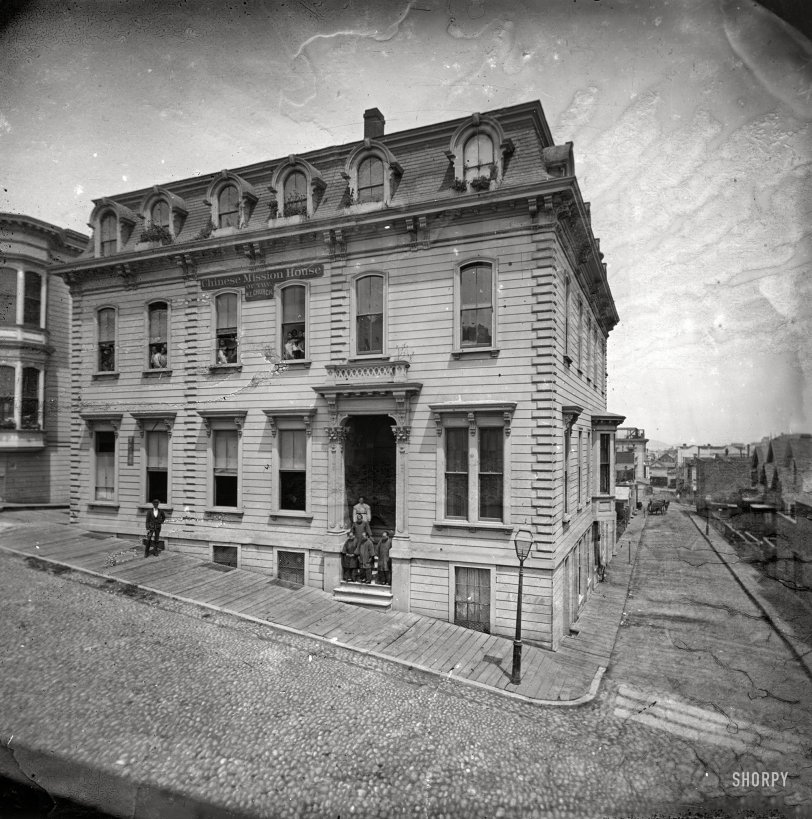


Framed or unframed, desk size to sofa size, printed by us in Arizona and Alabama since 2007. Explore now.
Shorpy is funded by you. Patreon contributors get an ad-free experience.
Learn more.

- Freeze Frame
- Texas Flyer wanted
- Just a Year Too Soon
- WWII -- Replacing men with women at the railroad crossing.
- Yes, Icing
- You kids drive me nuts!
- NOT An Easy Job
- I wonder
- Just add window boxes
- Icing Platform?
- Indiana Harbor Belt abides
- Freezing haze
- Corrections (for those who care)
- C&NW at Nelson
- Fallen Flags
- A dangerous job made worse
- Water Stop
- Passenger trains have right of way over freights?
- Coal
- Never ceases to amaze me.
- Still chuggin' (in model form)
- Great shot
- Westerly Breeze
- For the men, a trapeze
- Tickled
- Sense of loneliness ...
- 2 cents
- Charm City
- What an Outrage
- Brighton Park
Print Emporium
Chinese Mission House: 1880s

San Francisco circa 1880s. "Chinese Mission House of the M.E. Church, 916 Washington Street." 5x5 inch glass heliograph transparency, formerly of the Wyland Stanley and Marilyn Blaisdell collections. View full size.
Heliograph transparency
If I am right, this is the first time we encounter the term "heliograph transparency" at Shorpy's.
In the "Printmaking dictionary" you may find some explanations for the term, but, to be honest, it doesn't really make me wiser as what a heliograph transparency could be, although one of the explanations mentions a "reproductive process using a transparent support."
Universal Wooden Sidewalks
Wood sidewalks are not a San Francisco phenomenon based on slopes, they were pretty universal in 1880 and mostly used until 1900. Concrete and concrete construction improved after 1880 but were mostly focused on getting steel reinforcement improvements for construction. However a few concrete sidewalks existed by 1860.
Wood-plank sidewalks
Two possible explanations for the wood-plank sidewalks:
1. Wood was cheap and plentiful in San Francisco in the 1880s, before we chopped down the old-growth forests.
2. As someone who used to work in a factory where we poured concrete, I would say that pouring concrete sidewalks would definitely be a challenge on those steep San Francisco hills. The wet concrete would flow down the hill before it cured unless it was mixed very dry and salted with lime to promote faster curing. But those techniques tend to weaken the concrete. I don't know how they do it nowadays. Some steep San Francisco sidewalks are actually molded as steps!
Wooden it?
The place is built of wood, and the blocks you see that make it resemble a stone structure are known as quoins. Often seen on even simple buildings, and many stucco structures have similar. San Francisco had way more wooden buildings than masonry- in fact one of the biggest imports to the city was lumber, down to whole 'rafts' of it floated from up the coast. Try that with stone sometime!
I wooden be too sure
I think the building is made of wood, but made to look like stone.
Wooden sidewalks?
While raised wooden sidewalks were common in the west during this period, the cobbled streets, gas lamps and stone building in this image makes the (apparently) wood planks of the sidewalk seem out of place. Any urban pavement historians out there?
























On Shorpy:
Today’s Top 5